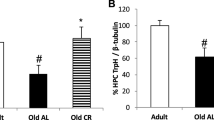Abstract
We investigated the effects of vitamin E deficiency on the monoamine metabolism in the rat brain. Male Wistar rats fed on the vitamin E deficient diet for 24 weeks were analyzed. At 28 weeks, they showed a reduced growth rate (52% of reduction), muscle atrophy, a motor weakness of hind limbs and disturbance of gait. The concentrations of monoamines, their precursors and metabolites in the brain were simultaneously determined using high performance liquid chromatography (HPLC) coupled with a coulometric detection with electrode array system. In addition, tryptophan hydroxylase activity was measured. The dopamine (p = 0.009) and serotonin (p = 0.04) levels in the brain stem of vitamin E deficients rats were significantly lower than in the controls, whereas their precursors tyrosine (p = 0.0009) and tryptophan (p = 0.0065) levels in the brain stem were significantly higher than in the controls. Moreover, tryptophan hydroxylase activity (p = 0.0005) in the brain stem of vitamin E deficient brains was significantly lower than in the controls. All statistical comparisons were done using non-parametric tests (Mann-Whitney U test). These results suggest that vitamin E deficiency may play a role in the disturbance of monoamine metabolism in rat brain.
Similar content being viewed by others
REFERENCES
Götz, M. R. E., Freyberger, A., and Riederer, P. 1990. Oxidative stress: a role in the pathogenesis of Parkinson's disease. J. Neural. Transm., 29(suppl):241–249.
Marsden, C. D. 1990. Parkinson's disease. Lancet 1:948–952.
Dexter, D. T., Carter, C., Wells, F. R.,and et al. 1989. Basal lipid peroxidation in substantia nigra is increased in Parkinson's disease. J. Neurochem., 52:381–389.
Kilinc, A., Yalcin, A. S., Yalcin, D., and et al. 1988. Increased erythrocyte susceptibility to lipid peroxidation in human Parkinson's disease. Neurosci. Lett., 87:307–310.
Pall, H. S., Williams, A. C., Blake, D. R., and et al. 1986. Lipid peroxidation and Parkinson's disease (letter). Lancet, 1:870–871.
Smith, M. R., Sandy, M. S., and Di Monte, D. 1987. Free radicals, lipid peroxidation and Parkinson's diseas (letter). Lancet 1:38.
Poirier, J., and Barbeau, A. 1987. Erythrocyte antioxidant activity in human patients with Parkinson's disease. Neurosci Lett., 75:345–348.
Ambani, L. M., Van Woert, M. N., and Murphy, S. 1975. Brain peroxidase and catalase in Parkinson's disease. Arch. Neurol., 32:114–118.
Kish, S. J., Morito, C., and Hornykiewicz, O. 1985. Glutathion peroxidase activity in Parkinson's disease. Neurosci. Lett., 58:343–346.
Perry, T.L., Godin, D.V., and Hansen, S. 1982. Parkinson's disease: a disorder due to nigral glutathion deficiency? Neurosci., Lett. 33:305–310.
Riederer, P., Sofic, E., Rausch, W. D., and et al. 1989. Transition metals, ferritine, glutathion, and ascorbic acid in parkinsonian brains. J. Neurochem., 52:515–520.
Friedrich, W. 1988. Vitamin E. Pages 219–286, in Friedrich, W. (ed), Vitamins, Walter de Gruyter, Berlin.
Grimes, J. D., Hassan, M.N., and Thakar, J. 1987. Antioxidant therapy in Parkinson's disease. Can. J. Neurol. Sci., 14(supple): 483–487.
Muller, D. P. R., Lyond, J.K., and Wolff, O. H. 1983. Vitamin E and neurological function. Lancet, 1:225–228.
Halliwall, B., and Gutteridge, J. M. C. 1990. The antioxidants of human extracellular fluids. Arch. Biochem. Biophys., 280:1–8.
Driskell, W.J., Neese, J.W., Bryant, C.C., and et al. 1982. Measurement of vitamin A and vitamin E in human serum by high performance liquid chromatography. J. Chromatogr., 231:439–444.
Siuciak, J. A., Gamache, P. H., and Dubocovich, M. L. 1992. Monoamines and their precursors and metabolites in the chicken brain, pineal and retina: regional distribution and day/night variations. J. Neurochem., 58(2):722–729.
Paxinos, G., and Watson, C. 1986. The rat brain in stereotaxic coordinates, in Paxinos G, and Watson C (eds), Academic Press, Australia.
Fujisawa, H., and Nakata, H. 1987. Tryptophan 5-monooxygenase from rat brain stem. Methods in Enzymology., 142:83–86.
Nagatsu, T., Oka, K., and Kato, T. 1979. Highly sensitive assay for tyrosine hydroxylase activity by high-performance liquid chromatography. J. Chromatogr., 163:247–252.
Golbe, L. I., Farrell, T. M., and Davis, P. H. 1988. Case-control study of early life dietary factors in Parkinson's disease. Arch. Neurol., 45:1350–1353.
Golbe, L. I., Farrell, T. M., and Davis, P. H. 1990. Follow-up study on early life protective and risk factors in Parkinson's disease. Mov. Disord., 5:66–70.
Férnandez-Calle, P., Molina, J. A., Jiménez-Jiménez, F. J., and et al. 1992. Serum levels of alpha-tocopherol (vitamin E) in Parkinson's disease. Neurology, 42:1064–1066.
Fahn, S. 1989. The endogeneous toxin hypothesis of the etiology of Parkinson's disease and a pilot trial of high dosage antioxidants in an attempt to slow the progression of the illness. Ann. NY. Acad. Sci., 570:186–196.
Perry, T. L., Yong, R. M., Clavier, K., and et al. 1985. Partial protection from the dopaminergic neurotoxin N-methyl-4-phenyl-1, 2,3,6-tetrahydropyridine by four different antioxidants in the mouse. Neurosci. Lett., 63:56–60.
Yong, W. W., Perry, T. L., and Krisman, A. A. 1986. Deletion of glutathione in brain stem of mice caused by N-methyl-4-phenyl-1,2,3,6-tetrahydropyridine is prevented by antioxidant pretreatment. Neurosci. Lett., 63:56–60.
Martinovits, G., Melamed, E., Cohen, O., and et al. 1986. Systemic administration of antioxidants does not protect mice against the dopaminergic neurotoxicity of 1-methyl-4-phenyl-1,2,3,6-tetrahydroxypyridine (MPTP). Neurosci. Lett., 69:192–197.
Perry, T. L., Yong, V. W., Hansen, S., and et al. 1987. α-Tocophenol and β-carotene do not protect marmosets against the dopaminergic neurotoxicity of N-methyl-4-phenyl-1,2,3,6-tetrahydropyridine. J. Neurol. Sci., 81:321–331.
Odunze, I. N., Klaidman, L. K., and Adams, J. D. Jr. 1990. MPTP toxicity in the mouse brain and vitamin E. Neurosci. Lett., 108:346–349.
Adams, J. D. Jr., Odunze, I. N., and Sevanian, A. 1990. Induction by 1-methyl-4-phenyl-1,2,3,6-tetrahydropyridine of lipid peroxidation in vivo in vitamin E deficient mice. Biochem. Pharmacol., 39:R5-R8.
MacEvilly, C., and Muller, D. P. R. 1996. Lipid peroxidation in neural tissues and fractions from vitamin E-deficient rats. Free. Radic. Biol. Med., 20(5):639–648.
Author information
Authors and Affiliations
Rights and permissions
About this article
Cite this article
Adachi, K., Izumi, M. & Mitsuma, T. Effect of Vitamin E Deficiency on Rat Brain Monoamine Metabolism. Neurochem Res 24, 1307–1311 (1999). https://doi.org/10.1023/A:1020937409855
Issue Date:
DOI: https://doi.org/10.1023/A:1020937409855



